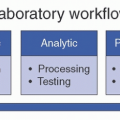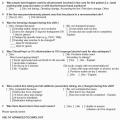Healthcare-Associated Infections in Obstetric Patients
Amanda L. Agard
Amy B. Kressel
The hospital obstetric unit is one of the first examples of a specialized hospital unit with a specialized patient population. “Lying-in” or obstetric hospitals were introduced in the 18th century, and some of the first significant studies on the epidemiology of healthcare-associated infections (HAIs) were made on obstetric services.1 Today’s hospital is increasingly becoming a collection of specialized units; these units contain unique patient populations undergoing specialized treatments for specific diseases. Patients on these units may be more vulnerable to infection, or characteristics of the unit may facilitate transmission of infections. Obstetric care is unique in that both the primary patient and the newborn infant are at risk.
A survey of postpartum infections reported an overall infection rate of 6% (Table 26-1).2 Ledger3 pointed out that the frequent empiric use of antibiotics for febrile patients on the obstetric service probably leads to lower reported infection rates and obscures the true frequency of HAIs. In recent decades, postpartum women have had shorter hospital stays. Shortened hospital stays may decrease exposure risk for HAIs and may result in decreases in infection rates. Unfortunately, shortened hospital stays also make surveillance of infections more difficult; thus, changes in infection rates cannot be confirmed by current data.
The establishment of obstetric hospitals in the mid-18th century created the setting for epidemics of puerperal infections.1 The epidemics in turn provided the opportunity both to demonstrate that puerperal fever was contagious and to develop prevention methods. Alexander Gordon was one of the first to document this,4 and, later, so did Oliver Wendell Holmes,5 but the most famous was Ignaz Semmelweis in Vienna because of his extensive and carefully detailed observations.6
The “great free Vienna Lying-In Hospital” created a natural epidemiologic experiment that Semmelweis had the insight to appreciate. The hospital had two separate divisions: the first division for teaching medical students and the second division for teaching midwives. The mortality was so much greater in the first division (16% vs 2% in the second division) that even the patients knew about it and tried to be admitted to the second division. Semmelweis took advantage of this natural experiment to carefully collect data to document and determine the cause of the epidemics. Not only did he evaluate the data on HAIs, but he also made anecdotal observations that supported his conclusions—the low infection rate in women who delivered in the street on the way to the hospital compared with those who delivered in the hospital.
The medical students in the first division performed autopsies, whereas the midwives did not. Semmelweis noted the similarity between the fatal illness in a pathologist who had been stuck in the finger by a medical student
and the fatal infections in the obstetric patients. He concluded that material from the autopsies was being transmitted back to the patients and causing their illnesses. Hand washing with soap was done after autopsies, so Semmelweis concluded that this was inadequate to remove all “cadaveric particles.” He added hand rinsing with chlorinated lime (calcium hypochlorite) water after performing autopsies and after each patient contact.7 The result was a dramatic decrease in mortality in the first division to rates similar to those of the second division.
and the fatal infections in the obstetric patients. He concluded that material from the autopsies was being transmitted back to the patients and causing their illnesses. Hand washing with soap was done after autopsies, so Semmelweis concluded that this was inadequate to remove all “cadaveric particles.” He added hand rinsing with chlorinated lime (calcium hypochlorite) water after performing autopsies and after each patient contact.7 The result was a dramatic decrease in mortality in the first division to rates similar to those of the second division.
It took decades for Semmelweis’ ideas, stimulated by Lister’s concept of antisepsis, to become standard practice. Even then, obstetric infections and maternal mortality remained major problems into the 1930s. The appearance of the first antimicrobial agents and improvements in other aspects of obstetric care resulted in a major decrease in maternal mortality.8 Presumably, the reason for the persistence of high obstetric infection rates into the 1900s was that even though epidemics of puerperal fever transmitted by cross infections were prevented by hand washing and antiseptic techniques, infection from patients’ endogenous flora remained a problem.
TABLE 26-1 Infection Rates (Cases/100 Deliveries) on Obstetric Services by Site of Infection, 1993-1995 | |||||||||||||||||||||||||||||||||||||||||
|---|---|---|---|---|---|---|---|---|---|---|---|---|---|---|---|---|---|---|---|---|---|---|---|---|---|---|---|---|---|---|---|---|---|---|---|---|---|---|---|---|---|
| |||||||||||||||||||||||||||||||||||||||||
PATHOGENESIS OF OBSTETRIC INFECTIONS
Most obstetric infections are caused by maternal vaginal and cervical flora; thus, infections usually relate to risk factors that allow endogenous flora to cause disease. Hospital pathogens are seldom problems on obstetric services, because obstetric patients have short stays and obstetric units are separated from other hospital units.
As Bartlett and coworkers9,10 pointed out, vaginal flora are a dynamic ecosystem, with some differences between vaginal and cervical flora. Anaerobic bacteria usually outnumber aerobes, with anaerobic and facultative lactobacilli predominating. Other anaerobes include Peptostreptococcus species, Bacteroides species, and Prevotella species. The aerobic Gram-positive flora include coagulase-negative staphylococci, streptococci, enterococci, and Staphylococcus aureus (including methicillin-resistant Staphylococcus aureus [MRSA]11); and the Gram-negative flora include Escherichia coli, Gardnerella vaginalis, Enterobacter species, Klebsiella pneumoniae, and Proteus mirabilis.12,13 Both Mycoplasma and Ureaplasma are also found in the vagina. Sexually transmitted diseases may add Neisseria gonorrhoeae, Chlamydia trachomatis, or herpes simplex virus (HSV) to this flora. Vaginal flora may change during pregnancy. Some studies suggest that lactobacilli increase in pregnancy and that other anaerobes decrease.14 Antibiotics also change the flora, and the use of multiple doses of cephalosporins for prophylaxis has been reported to increase enterococci and perhaps Enterobacter species.15
As would be expected, most obstetric intrauterine infections are polymicrobial, representing contiguous spread from the vagina.16 Ascending infection is demonstrated by both the presence of routine cervicovaginal flora in endometritis and surgical site infections (SSIs) and the ability to predict postcesarean infections by intraoperative lower uterine cultures.17 Although a substantial proportion of postcesarean SSIs are caused by staphylococci, as in other SSIs, most postcesarean infections are caused by endometrial contamination.18
Many risk factors have been proven or suggested to be associated with endometrial infection, including those that increase entry of vaginal flora such as prolonged rupture of the membranes, frequent vaginal and rectal examinations, or intrauterine monitoring; those that result in tissue injury such as soft tissue trauma, midforceps delivery, or inexperienced surgeons; and host factors that are associated with increased infections such as maternal age, lower socioeconomic status, diabetes mellitus, or obesity. Understanding these risk factors may become important in evaluating infection rates on specific obstetric units.
OBSTETRIC INFECTIONS (INFECTIONS RELATED TO PREGNANCY AND DELIVERY)
Postpartum Endometritis
The classic obstetric infection is postpartum endometritis. The postpartum patient develops fever that may be associated with abdominal pain, uterine tenderness, malaise, or foul-smelling discharge. In most cases, the patient is started on antibiotics without obtaining cultures.16 Endometritis can occur after either vaginal delivery or cesarean section but is more common after cesarean section. Infection has been reported to occur after fewer than 3% of vaginal deliveries and 5%-95% of cesarean sections.2,16,19 The variation in infection rates results from the variation in risk factors in the population studied and patient’s management. Endometritis after cesarean section occurs earlier than after vaginal delivery, as shown by hospital readmissions for postpartum endometritis. Most women who were readmitted for endometritis had delivered vaginally.20
Endometritis may be caused by either a single bacterial species or multiple microorganisms.21 Common etiologic agents include the Gram-positive cocci, such as streptococci and enterococci; Gram-negative bacilli, such as E coli, K pneumoniae, and P mirabilis; and anaerobes, such as Bacteroides bivius and peptostreptococci.16,21,22 Some studies have distinguished between early and late postpartum endometritis23,24; late infection is a milder disease that occurs after vaginal delivery. It has been suggested that genital Mycoplasma and Chlamydia are important etiologic agents in late endometritis.
The most important risk factor for postpartum endometritis is cesarean section, and the risk of infection is greatest when it is a nonelective procedure after rupture of the membranes and the onset of labor.16,19,25 General anesthesia, long duration of surgery, intraoperative problems, and poor surgical technique may all be risk factors. Currently patients undergoing both elective and nonelective cesarean sections are routinely given prophylactic antibiotics as they are shown to decrease postpartum endometritis and wound infections by 50%-75%.26 Administration of intravenous antibiotics is done before skin incision as it has been shown to be more effective than administration at cord clamping, the previous practice.27,28 In vaginal deliveries, prolonged rupture of the membranes, midforceps delivery, and soft tissue trauma increase the risk. With many other risk factors for postpartum endometritis, it is difficult to separate out relative risks, because the factors are interrelated. This applies to risk factors such as prolonged labor, frequent vaginal examinations, and internal monitoring. Host factors that increase risk include bacterial vaginosis, human immunodeficiency virus (HIV) infection, anemia, low socioeconomic status, maternal age, and obesity.25,29,30
Infection of the endometrium may extend into the myometrium and parametrial tissue, causing abscess formation or sepsis. Septic pelvic thrombophlebitis (SPT) should be suspected in a patient who does not respond to antibiotic therapy.31 If the workup fails to identify another infection, computed tomography should be performed to look for pelvic thrombophlebitis. Past treatment included the addition of heparin to broad-spectrum antimicrobial therapy. However, a large randomized trial of SPT showed no benefit from adding heparin to antimicrobial therapy when compared to those receiving antimicrobial therapy alone.32
Evaluation of the febrile postpartum patient should include a relevant history and physical exam along with laboratory studies: complete blood count, chest x-ray, urine culture, and blood cultures. Leukocytosis is usually present but may also be seen in the noninfected postpartum patient. Uterine cultures are often not done because of the difficulty in interpreting the results. Because the microorganisms recovered are usually part of the normal maternal flora, these may either represent contamination during specimen collection or be the cause of endometritis. Unless a blood culture is positive, there is no way to confirm that the isolates are significant. However, good aerobic and anaerobic cultures do show the range of potential pathogens and detect infections caused by unusual pathogens such as the rare group A β-hemolytic streptococci (GABHS) infection. Uterine cultures may also be helpful in patients that fail standard therapy. Uterine cultures can be collected with a cotton swab.33
Intrapartum HIV
Effective antiretroviral therapy (ART) has changed intrapartum management of HIV-infected women. In virally suppressed women (HIV RNA < 1000 copies/mL), premature rupture of membranes has not led to maternal-fetal HIV transmission.34,35 It is not known if fetal exposure to maternal blood, such as via invasive fetal monitoring (eg, scalp electrodes), forceps extraction, or episiotomy, is safe in women with viral suppression. Therefore, it is currently recommended to avoid (1) artificial rupture of membranes in women with HIV RNA < 1000 copies/mL (BIII), (2) fetal scalp electrodes in all HIV-infected women (BIII), and (3) operative delivery with forceps or a vacuum extractor in all HIV-infected women (BIII). Invasive fetal monitoring should similarly be avoided in women with other blood-borne pathogens (eg, HBV, HCV).36
Surgical Site Infections
Episiotomy infections are uncommon and usually not serious, but severe complications such as necrotizing fasciitis can develop.37,38 Episiotomy sites should be examined carefully to detect infection early, and infections should be treated to prevent complications.
A more serious problem is SSI of a cesarean section. SSIs are reported to occur in about 3%-4% of cesarean section patients, including both incisional and organ and space infections.2,39 This rate has declined, perhaps as a result of administering perioperative antibiotics just prior to incision.40 The administration of azithromycin in addition to cefazolin has been shown to reduce rates of both endometritis and wound infections after cesarean section following prolonged rupture of membranes.41 The proposed mechanism of action for the azithromycin is prevention of infection from ascending genital mycoplasma. SSIs are usually caused by maternal flora in the endometrium but, as with any other SSI, can be caused by microorganisms from exogenous sources.18,42 In the latter cases, S aureus is the most frequent cause of infection. Although the pathogenicity of genital mycoplasma in SSIs has not been proved, a study reported these to be the most common bacteria isolated in infected postcesarean surgical sites.42 SSIs should be cultured before antibiotic therapy is begun (see also Chapter 21).
Urinary Tract Infection
Urinary tract infections are a common problem in pregnancy and during the postpartum period.43 Risk factors for postpartum infections include urinary retention from anesthesia, trauma during delivery, and the need for catheterization. Urine cultures of the febrile patient with urinary tract symptoms should always be collected, although midstream samples may be contaminated by vaginal discharge. In those cases, the results are interpreted in the context of the clinical findings and the response to empiric antibiotic therapy. The major preventable risk factor in the postpartum period is catheterization. Catheterization is indicated for urinary retention but should be done only as needed,44 with the catheter removed as soon as possible. Another risk factor for postpartum urinary tract infection is bacteriuria during pregnancy. Pregnancy is one of the few conditions for which treatment of asymptomatic bacteriuria is indicated.45 A urine culture should be collected at one of the initial prepartum visits during early pregnancy. A UTI or asymptomatic bacteriuria should be treated for 4-7 days in a pregnant woman. There is insufficient evidence for or against repeat screening or test of cure.45
Chorioamnionitis (Intra-amniotic Infection)
Intrauterine infection during pregnancy, such as postpartum endometritis, is usually caused by ascending infection
from vaginal flora and is caused by similar bacteria.16,45,46 Most infections are also polymicrobial, and the major risk factor is prolonged rupture of the membranes. Infection is rare in women with intact membranes. Other risk factors are similar to those for postpartum endometritis: duration of labor, number of vaginal examinations, internal monitoring, and possibly bacterial vaginosis. A variety of other obstetric procedures may introduce infection, including amniocentesis, chorionic villus sampling, and percutaneous umbilical blood sampling.
from vaginal flora and is caused by similar bacteria.16,45,46 Most infections are also polymicrobial, and the major risk factor is prolonged rupture of the membranes. Infection is rare in women with intact membranes. Other risk factors are similar to those for postpartum endometritis: duration of labor, number of vaginal examinations, internal monitoring, and possibly bacterial vaginosis. A variety of other obstetric procedures may introduce infection, including amniocentesis, chorionic villus sampling, and percutaneous umbilical blood sampling.
Because fever can be the only presenting sign, initial diagnosis may be difficult. Specific diagnosis requires examination of amniotic fluid by gram stain, culture, and amniotic fluid glucose level.47 Healthcare-associated chorioamnionitis can be suspected in patients who become febrile after vaginal examinations, internal fetal monitoring, or other such procedures, but there is no standardized definition for HAI. Once the diagnosis is suspected, the patient should be started on broad-spectrum antibiotic therapy, including anaerobic coverage, and delivered as soon as possible.
Mastitis
In a study of obstetric patients who were contacted after discharge from the hospital, mastitis was the most common infection reported.48 Very few breast infections were seen during hospitalization, because mastitis and breast abscess usually occur several weeks into the postpartum period. A slight fever can develop early with breast engorgement, but it is transient. Later in the postpartum period, infectious mastitis must be distinguished from milk stasis and noninfectious inflammation.49 Infection is associated with higher fevers, erythema, and unilaterality.
The most common cause of breast infection is S aureus.50 Epidemics of staphylococcal mastitis occurred in the past but have not been reported in recent years. Therefore, the traditional classification of infectious mastitis into sporadic and epidemic forms is seldom useful. Both types are usually caused by S aureus. Increasing numbers of cases due to community-acquired MRSA are also being reported.51 Predisposing factors for mastitis include the lack of nipple care, poor feeding technique, and inadequate emptying of the breasts. Infection can be confirmed by Gram stain and culture and responds to antistaphylococcal antibiotics and, if needed, surgical drainage. Continued breast drainage is important and can be accomplished by continued nursing, if appropriate, or pumping and discarding milk.
Stay updated, free articles. Join our Telegram channel

Full access? Get Clinical Tree






